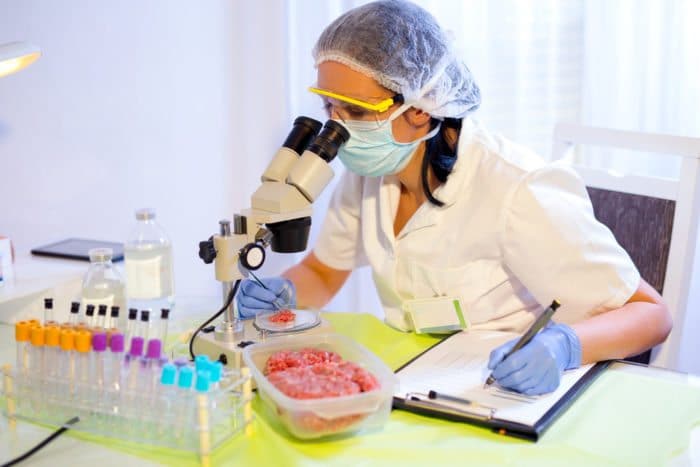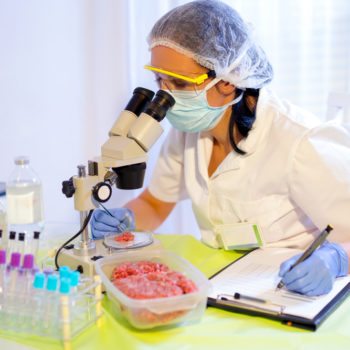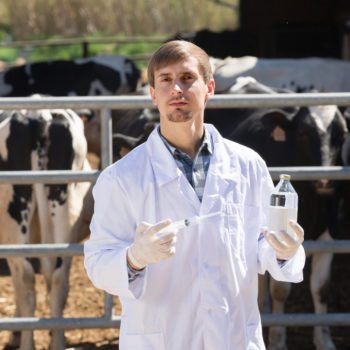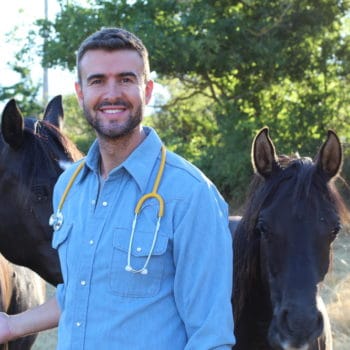Why We Love It
-
$72,030Potential Avg. Salary
-
3.9%Job Growth Rate
-
Growing DemandJob Outlook
-
Good Entry Level SalaryCareer Attribute
Food scientists study the composition, nutrition, processing, and preservation of food. They may work to ensure that ingredients match the information on food item nutrition labels, to test food products for the presence of bacteria, or to develop new methods of processing and preserving packaged foods.
Recommended Schools
What is a Food Scientist?
The following job responsibilities are common for individuals in food scientist roles:
- Perform laboratory testing of packaged food items to ensure item ingredients and amounts match what’s listed on nutrition information labels
- Conduct ongoing testing of agricultural and packaged foods to ensure no bacteria or other elements are present that could lead to foodborne illness if consumed
- Use nanotechnology techniques to develop tests that can automatically detect dangerous bacteria in food products
- Research combinations of ingredients to develop recipes for appealing food products
- Study food production and preservation techniques to invent new processes that lead to faster or safer production, processing, and preservation of packaged foods
A Day in the Life
Food scientists may specialist in three distinct areas: they may be responsible for testing food for dangerous bacteria, they may be responsible for creating new food recipes, or they may be responsible for improving food production by developing faster or safer methods of food processing or preservation. In all roles, food scientists use their knowledge and skills to ensure that food purchased in grocery stores throughout the U.S. is safe to consume, has an appealing taste, and matches published nutritional information.
Some food scientists focus their tests on ensuring food is safe to eat. They test for the presence of bacteria that could cause foodborne illness if consumed. These tests could be conducted on meat products, fruits and vegetables, or packaged food items. These food scientists may also apply the techniques of nanotechnology to the testing process to develop faster and more accurate means of detecting dangerous bacteria in food items. They may also ensure that food matches the ingredients and fat/sugar/calorie/sodium contents in food match published nutritional information.
Other food scientists are responsible for developing new food recipes. Some may work to develop new recipes for candy, condiments, canned goods, and other packaged foods. These food science technicians work in food manufacturing and develop the recipes for innovative new food products that can be sold in grocery stores throughout the U.S. Others may work to form new means of packaged food preservation that lead to faster, more efficient, safer, or healthier means of preserving packaged foods.
Typical Work Schedule
Most food science technicians work full-time schedules during normal business hours. Some may be required to work overtime, to travel for work, or to work irregular shifts, but these requirements are uncommon.
Typical Employers
Food science technicians commonly work for government agencies like the Food and Drug Administration, for food production or manufacturing companies, for universities, or in agriculture.
Recommended Schools
How To Become a Food Scientist
The minimum educational requirement for finding work as a food scientist is a bachelor’s degree, though many employers prefer to hire candidates with advanced degrees. A good starting point for a career as a food scientist is to earn a bachelor’s degree in a related field. Popular majors include biology, physics, chemistry, or animal science. With a bachelor’s degree, you should be able to find entry-level work in the field as a food science technician, assisting experienced food scientists with tests.
It’s possible to advance in a career as a food scientist with only a bachelor’s degree and many years of professional experience as a food science technician or food scientist. This is especially true for food production and manufacturing industry work. However, to advance into mid- or senior-level positions with government agencies or universities, a graduate degree is usually required. Some positions may require a master’s degree, and some may require a Ph.D.
Food scientists who want to work in management positions usually need a master’s degree in a related field: biology, animal sciences, or food sciences. For those who want to conduct independent research in the field of food science, a Ph.D. is required. A master’s degree is usually required before you can enter a Ph.D. program, and then a Ph.D. requires another four years of study in college. Common Ph.D. programs include food science, food science and technology, or food science and human nutrition.
Food Scientist Salary Data
We’ve provided you the following to learn more about this career. The salary and growth data on this page comes from recently published Bureau of Labor Statistics data while the recommendations and editorial content are based on our research.
National Anual Salary
Low Range
$49,140Average
$72,030High Range
$118,390National Hourly Wage
Low Range
$24/hrAverage
$35/hrHigh Range
$57/hrHow do Food Scientist salaries stack up to other jobs across the country? Based on the latest jobs data nationwide, Food Scientist's can make an average annual salary of $72,030, or $35 per hour. On the lower end, they can make $49,140 or $24 per hour, perhaps when just starting out or based on the state you live in.
Salary Rankings And Facts
#184 Nationally for All Careers
Above Average Salary Nationally
Programs and Degrees
Here are the most common degrees for becoming a Food Scientist. a is usually recommended and specifically a degree or coursework that prepares you for the particular field, see below.
Highest Education Among Food Scientists
- 14.2% Doctorate
- 21% Masters
- 45.8% Bachelors
- 8% Associates
- 10.9% College
- 0.2% High School
- 0% Less than High School
Job Growth Projections and Forecast
2014 Total Jobs
15,4002024 Est. Jobs
16,000Job Growth Rate
3.9%Est. New Jobs
600How does Food Scientist job growth stack up to other jobs across the country? By 2024, there will be a change of 600 jobs for a total of 16,000 people employed in the career nationwide. This is a 3.9% change in growth over the next ten years, giving the career a growth rate nationwide of Above Average.
Growth Rankings And Facts
#484 Nationally for All Careers
Above Avg. Growth Nationally
What Companies Employ The Most Food Scientists
| Industry | Current Jobs | New Jobs Needed | % Increase |
|---|---|---|---|
| Research and development in the physical, engineering, and life sciences | 2,100 | 100 | 0% |
| Other food manufacturing | 1,900 | 100 | 0% |
| Management of companies and enterprises | 1,600 | 100 | 0% |














